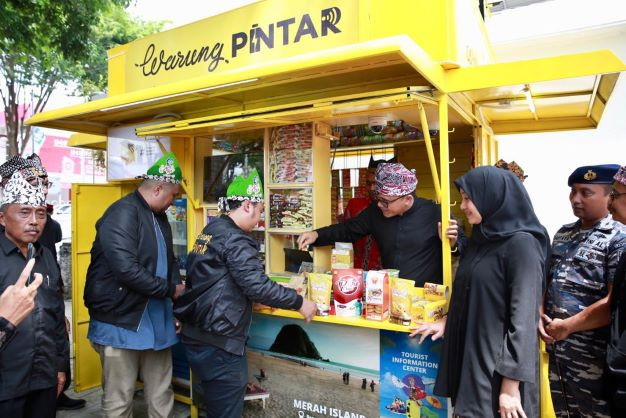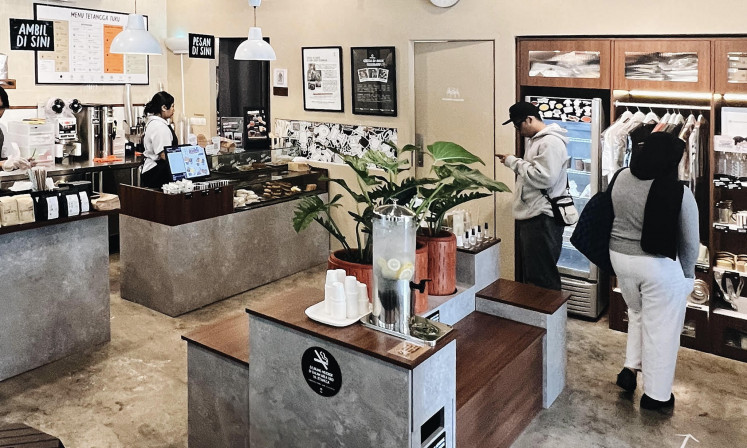Popular Reads
Top Results
Can't find what you're looking for?
View all search resultsPopular Reads
Top Results
Can't find what you're looking for?
View all search resultsThe future of retail is digital, but it’s not the end of mom-and-pop stores
Statista and the World Bank estimate that about 10 percent of all adult populations of Malaysia, Thailand, Indonesia, and Singapore use e-wallets.
Change text size
Gift Premium Articles
to Anyone
S
outheast Asia's digitalization in the past years has been nothing short of phenomenal, and one clear beneficiary has been e-commerce, as digital commerce and the ecosystem around it experienced a boom during the pandemic.
For example, 87 percent of Indonesians made an online purchase in the first month of 2021, more than any other country in the world, according to web audience tracker GWI. Thailand and Malaysia ranked third and fourth.
Traditional brick-and-mortar retail, however, is not quite dead yet.
In fact, e-commerce still only accounts for 9 percent of the overall retail market sales in ASEAN, according to data points from Euromonitor. Even the leading nations, China and the United States only get 27 percent and 20 percent online commerce penetrations, respectively. Pure e-commerce brands—like Amazon in the US — are now discovering brick and mortar by opening physical stores.
Generally, we see three main trends coming out of the pandemic.
First, technology is evolving fast. Augmented reality supplements the deficiencies of e-commerce, projecting virtual things on top of the real world. Shops are experimenting with computerized fitting rooms that remind us of the Pokemon Go game.
Second, payment technologies have improved tremendously, and new services have emerged. Super apps come with digital money options, and their operators compete for banking licences in different markets.
Today, Statista and the World Bank estimate that about 10 percent of all adult populations of Malaysia, Thailand, Indonesia, and Singapore use e-wallets, with these penetration rates already well ahead of some advanced economies.
Buy Now, Pay Later (BNPL) options have also appeared as a new form to extend credit to consumers and have been seeing explosive growth, especially given that only 9 percent of people above the age of 15 in Southeast Asia possess a credit card, according to 2017 data from the World Bank. In Singapore, the financial regulator is closely monitoring the BNPL sector as transactions reached S$440 million (US$320 million) in 2021.
Third, adjacent businesses in the ecosystem are flourishing and have managed to raise large funding rounds. As transactions move online, cybersecurity gains importance and "Big Data" analytics.
In addition, delivery service providers are thriving; Ninja Van last year became a unicorn, while Singapore-headquartered delivery platform Parcel Perform managed to raise S$27.6 million in a financing round which was led by Cambridge Capital, with existing partners SoftBank Ventures Asia, Wavemaker Partners, and Investible also being involved.
Simply put, the entire ecosystem is thriving because of e-commerce.
The battle for the mom-and-pop stores. The rise of e-commerce has not led to the demise of traditional provision shops.
The mom-and-pop shops maintain their dominance, with a 60-70 percent share in countries like Indonesia and the Philippines. Large players have now entered the space, supporting the local stores in their digitalization.
In Indonesia, start-ups like Warung Pintar, recently acquired by Sirclo, stand for the fundamental change that technology has brought to developing countries. On its platform, the firm offers the owners of small shops, also known as warung, a comparison portal to see which distributors have the cheapest offers. It also allows the businesses to manage their stock with artificial intelligence tools and data analytics based on past trends.
Warung Pintar even provides 40-day credits and cash advancements to around 500,000 users in the country.
Southeast Asia has overall been late in joining the e-commerce train, and companies that invested early in digital are faring much better than those who entered during the pandemic.
Singapore-based and New York Stock Exchange-listed Sea Group has a solution that lets people pay utility bills at warungs. This wasn't possible only a few years back and is something that is unique that has been developed in this region.
As for the big global e-commerce firms, they will have to think hard about where they can add value, as the local unicorns have gained a strong foothold.
We still see possibilities related to customer satisfaction. Currently, user expectations are not very high. But tech-driven customer satisfaction could become more important in the future, opening the door for new entrants that can make a difference.
For retail brands, the hybrid model is still extremely important. Clients want to experience the product, and therefore retailers need a physical location that enables just that. Apple stores are a place for people to feel the vibe and coolness of the products, not necessarily to purchase them.
Retail-as-a-service (RaaS) firms offer spaces for manufacturers to showcase their products.
Brand no longer own or rent the stores; they just pay a fee to the RaaS provider, who does all the rest, such as monitoring consumer behaviour in the shop and accumulating data for the manufacturer to improve the product.
A platform like Leap provides all key elements required for successful omnichannel retail, including real estate, shop design, operations, and technology. Selected products on the shelves are accompanied by the storytelling of the shop assistants, that behave more like actors.
What does retail of the future look like? The retail industry is evolving swiftly, and tech is at the heart of it. Data is preventing people from wasting time thinking about what to purchase or running out of necessities at home.
Amazon 4-star offers only products rated four stars or above, while Amazon's Dash Replenishment Service (DRS) automatically reorders missing items for the fridge or storage room if a sensor detects a need.
Both could be successful in cities like Singapore, where people are typically too busy to think about those things. Sensors will also gain importance in stores, identifying a client when entering and remembering shopping habits for the next visit.
Most of the tasks of a traditional clerk will be automated, and shop assistants will be able to focus on what needs to be done by a human, with the main duty to satisfy the customer.
On the other hand, the metaverse will try to recreate the physical store, and while this still feels much like Science Fiction in the West, people in this region might be more inclined to it.
Asians have embraced beauty filters and like to associate themselves with avatars, opening up many opportunities for the industry. With in-game sales surging and NFT shoes selling at more than Rp 30 million (US$2,068) a pair the new reality it's probably not that far away. But that does not necessarily mean the end of the traditional mom-and-pop stores that have been in existence for centuries.
***
The writer is a partner at Arthur D. Little.










